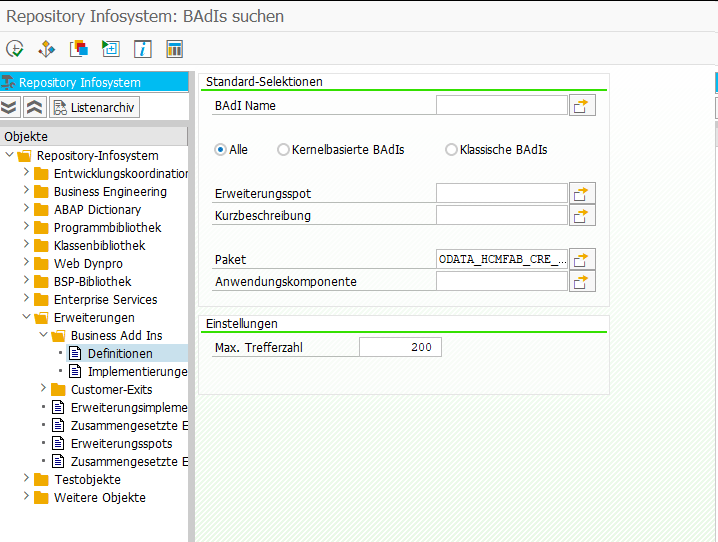* Option 1
DATA lt_data TYPE STANDARD TABLE OF x255.
CALL FUNCTION 'SCMS_XSTRING_TO_BINARY'
EXPORTING
buffer = lv_xstring
TABLES
binary_tab = lt_data.
* Option 2
cl_scp_change_db=>xstr_to_xtab( EXPORTING im_xstring = lv_xstring
IMPORTING ex_xtab = DATA(lt_data) ).
* Option 3
DATA(lt_data) = cl_bcs_convert=>xstring_to_solix( lv_xstring ).
Category: SAP
SAP
[Fiori] My Inbox – Tasks not appearing in Inbox
There are many reasons why a workflow task might not appear in the Inbox app. One reason I always forget to check is quite simple.
Check whether a scenario is configured!
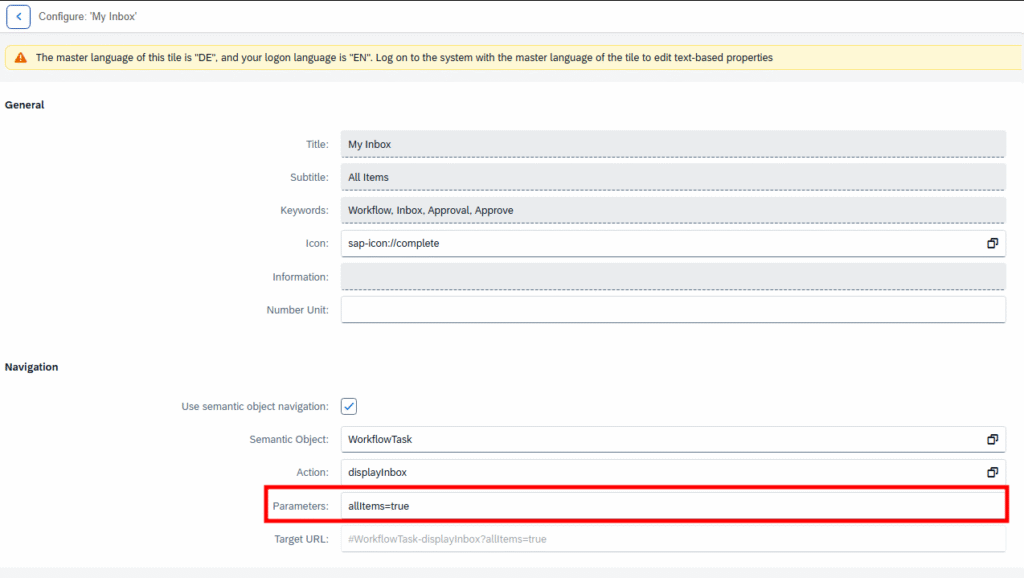
Simply open the Tile configuration and check the Parameter field. If there is a scenario, it would be something like scenarioId=EHS_HS_HAZMAT instead of allItems=true.
If a scenario is in use, you can find more about it in the customizing here:
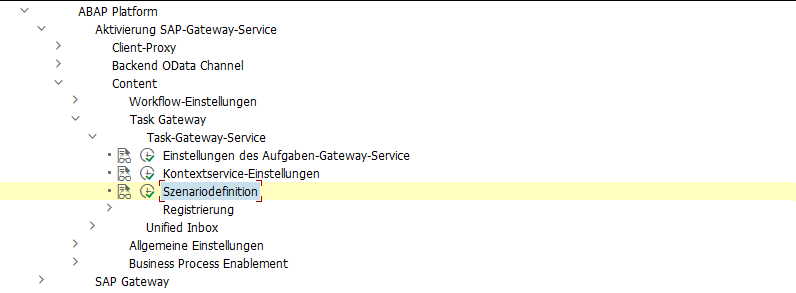
In a scenario, a restriction to certain workflow tasks can be configured.
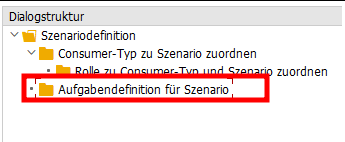
More information can be found here:
https://help.sap.com/docs/SAP_S4HANA_ON-PREMISE/8308e6d301d54584a33cd04a9861bc52/68c4379a35f644f6b3a73428594d6c3f.html?locale=en-US&version=LATEST
https://community.sap.com/t5/technology-blog-posts-by-sap/sap-fiori-for-sap-s-4hana-fiori-my-inbox-part-1-activation/ba-p/13326175
[ABAP] Selektionsparameter mit Suchhilfe für Personalnummern
Da ich es immer wieder nachschauen muss, schreibe ich es hier mal auf.
PARAMETERS p_pernr TYPE pernr_d OBLIGATORY MATCHCODE OBJECT prem.
[ABAP] Terminverfolgung IT0019 – Bemerkungen / Text auslesen
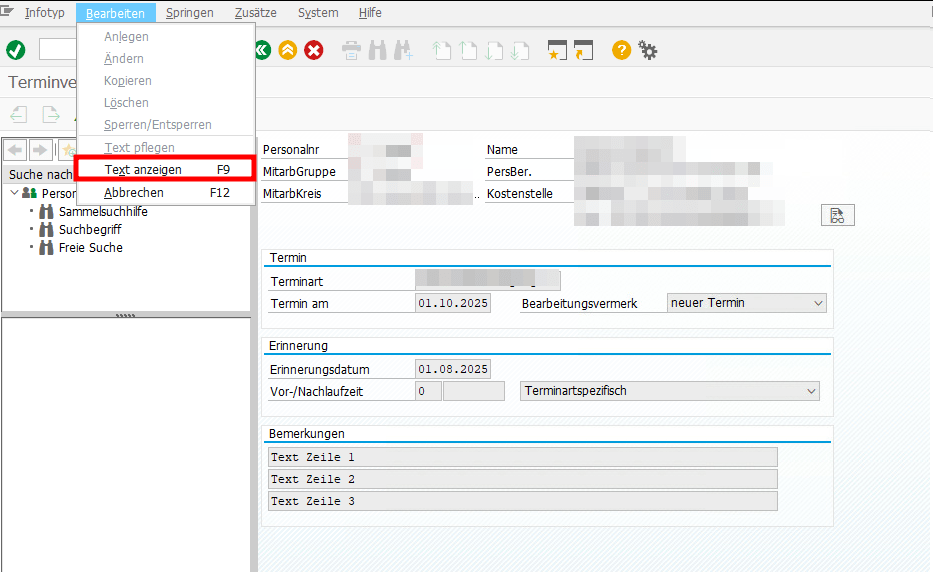

DATA infotype_text TYPE TABLE OF hrwpc_s_infotype_text.
CALL FUNCTION 'HRWPC_RFC_IT0XXX_TEXT_GET'
EXPORTING
pskey = CORRESPONDING pskey( p0019 )
TABLES
infotype_text = infotype_text.
DATA(text) = REDUCE #( INIT str = || FOR line IN infotype_text NEXT str = str && | | && line-textline ).
[Fiori] Abwesenheitsantrag in Inbox für nicht genehmigungspflichtige Abwesenheitsart
Kürzlich hatte ich die Situation, dass eine Führungskraft einen Abwesenheitsantrag in der Inbox hatte für eine Abwesenheitsart, die eigentlich nicht genehmigungspflichtig ist. Es hätte also gar kein Genehmigungsworkflow gestartet werden dürfen. Merkwürdigerweise war die beantragte Abwesenheit auch bereits im Infotyp verbucht. Auch konnte man den Antrag in der Inbox weder Ablehnen noch Genehmigen, beides lief auf ein Fehler.
Wie kam es also zu dieser Situation?
Der Mitarbeiter hatte einen Antrag mit einer genehmigungspflichtigen Abwesenheitsart gestellt, wie z.B. Urlaub.

Bevor der Genehmiger diesen Antrag bearbeitet hat, wurde der Antrag vom Antragsteller jedoch nochmal abgeändert. Dies ist über das Stift-Symbol möglich. Dabei wurde dann eine nicht genehmigungspflichtige Abwesenheitsart gewählt, wie z.B. Abbau Überzeit.

In diesem Fall wird der Antrag ohne Genehmigungsprozess durchlaufen und die Abwesenheit wird kurz darauf direkt in den Infotyp geschrieben durch den Verbucherreport.

Jedoch gab es ja bereits einen laufenden Workflow mit einem Workitem in der Inbox des Genehmigers und dieser wurde nicht beendet. Stattdessen wurde in dem Workitem sogar die beantragte Abwesenheitsart aktualisiert, obwohl für diese Abwesenheitsart ja gar keine Genehmigung erforderlich ist und sogar bereits in den Infotyp geschrieben war.
Auch in der Antragsdatenbank spiegelt sich das Problem wider. Der Antrag stand dort im Status ‘POSTED‘ und der Workflow-Status auf ‘STARTED‘.
Ich habe das Szenario dann mit einer Zweiten, nicht genehmigungspflichtigen Abwesenheitsart getestet, also Urlaub erfasst und vor Genehmigung die Abwesenheitsart geändert. Hier wurde jedoch der laufende Workflow korrekterweise beendet.

Als ich beide Abwesenheitsarten in der V_T554S_WEB verglichen habe, ist mir aufgefallen, dass bei der problembehafteten Abwesenheitsart ein Workflow gecustomized war, obwohl diese ja nicht genehmigungspflichtig ist. Der Workflow wurde jedoch nur verwendet, um eine Info-Mail zu versenden.
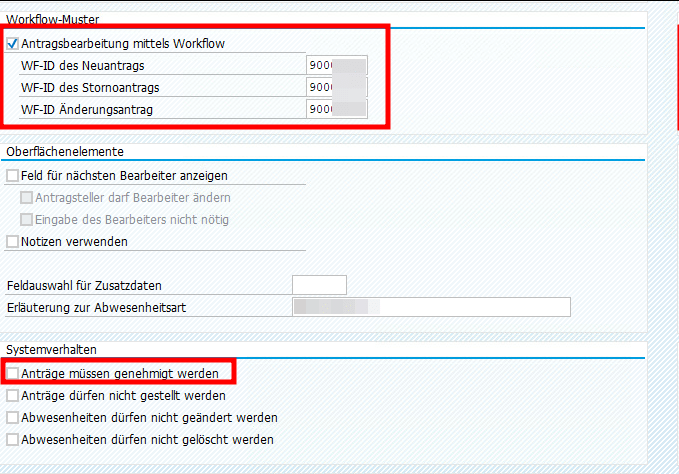
Die Workflow Checkbox ließ sich leider nicht deaktivieren (vermutlich weil es schon Anträge zu der Abwesenheitsart gibt). Aber es scheint, als führt dieses Workflowcustomizing dann zu Inkonsistenzen, wenn in einem laufenden Antrag von einer genehmigungspflichtigen Abwesenheitsart zu einer nichtgenehmigungspflichtigen gewechselt wird.
Dieser Post nur als Erinnerung, falls ich nochmal in so eine Situation laufe. Vielleicht habe ich dann die Chance, es zu verifizieren.
[ABAP] Sachbearbeiter ermitteln
Bisher kenne ich keine “offizielle” Klasse der SAP für die Sachbearbeiterermittlung. Auf jedem System dafür eine neue Helper Klasse/Methode anzulegen finde ich aber auch nervig. Ich nutze daher diese Klasse aus dem Notification Tool Paket P99_NT, nicht optimal, erfüllt aber seinen Zweck.
cl_hrpay00_nt_read_db=>get_admin_data( EXPORTING iv_pernr = pernr-pernr
IMPORTING es_sacha = DATA(es_sacha)
ev_usrid = DATA(ev_usrid)
ev_sbmod = DATA(ev_sbmod)
es_p0001 = DATA(es_p0001) ).
[ABAP] Read E-Mail-Template
Addition to https://nocin.eu/abap-e-mail-templates-in-s-4hana/
I had to create an E-Mail template where I did not need a CDS view or any variable at all. I simply needed the defined mail template without any rendering of class cl_smtg_email_api.
Solution: Reading the plain mail template can be achieved using class cl_smtg_email_template and method get_tmpl_cont:
DATA(ls_mail_content) = cl_smtg_email_template=>get( p_mailtx )->get_tmpl_cont( iv_langu = 'D' ).
Full sample:
PARAMETERS: p_mailtx TYPE smtg_tmpl_id OBLIGATORY.
TRY.
" get mail template
DATA(ls_mail_content) = cl_smtg_email_template=>get( p_mailtx )->get_tmpl_cont( iv_langu = 'D' ).
" optional: dynamic manipulation of html email body
" create mail document
DATA(lo_mail_document) = cl_document_bcs=>create_document( i_type = 'HTM'
i_subject = conv #( ls_mail_content-subject )
i_text = cl_bcs_convert=>string_to_soli( ls_mail_content-body_html ) ).
" create Sender & Receiver
DATA(lo_sender) = cl_cam_address_bcs=>create_internet_address( i_address_string = 'noreply@example.com'
i_address_name = 'Test' ).
DATA(lo_recipient) = cl_cam_address_bcs=>create_internet_address( i_address_string = 'max.mustermann@example.com').
" create Business Communication Service
DATA(lo_bcs) = cl_bcs=>create_persistent( ).
lo_bcs->set_document( lo_mail_document ).
lo_bcs->set_sender( lo_sender ).
lo_bcs->add_recipient( lo_recipient ).
lo_bcs->send( ).
COMMIT WORK.
CATCH cx_smtg_email_common INTO DATA(ls_cx).
DATA(lv_message) = ls_cx->get_text( ).
MESSAGE e899(id) WITH 'Unable to send message:'(004) lv_message.
ENDTRY.
[HR] Infotype 0105 Customizing – Table T591C
You can use SM30 and View V_T591C to configure whether USRID or USRID_LONG should be used for a subtype of infotype 0105.
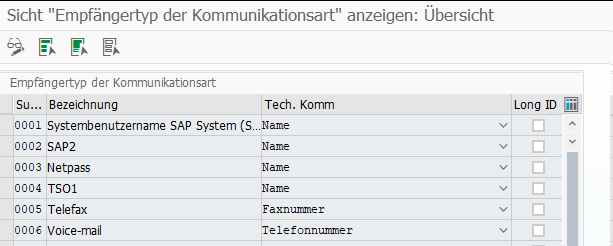
[SAP] Tabellenname zu SPRO Customizing ermitteln
Gerade einen hilfreichen Trick gelernt, wie man den Namen einer Tabelle ermitteln kann. Angenommen man ist in der SPRO unterwegs und möchte den Namen der zugehörigen Tabelle des Customizingschritts ermitteln, kann man versuchen über F1 → Technische Info → Tabellenname den Namen zu finden. Häufig steht dort allerdings nur der View-Name, und der muss nicht zwangsläufig den Namen der Tabelle enthalten. Ein Fall wie V_T77PT_OVT_APPL ist einfach, da man nur V_ entfernen muss für den Tabellennamen T77PT_OVT_APPL. Falls man es aber nicht aus dem View-Namen ableiten kann, einfach in der Transaktion SM12 nach den Sperreinträgen zu dem eigenen User schauen. Dort findet man in der letzten Spalte Sperrargument den Tabellennamen. Die Tabelle muss dafür natürlich in einem anderen Modus noch geöffnet sein.

